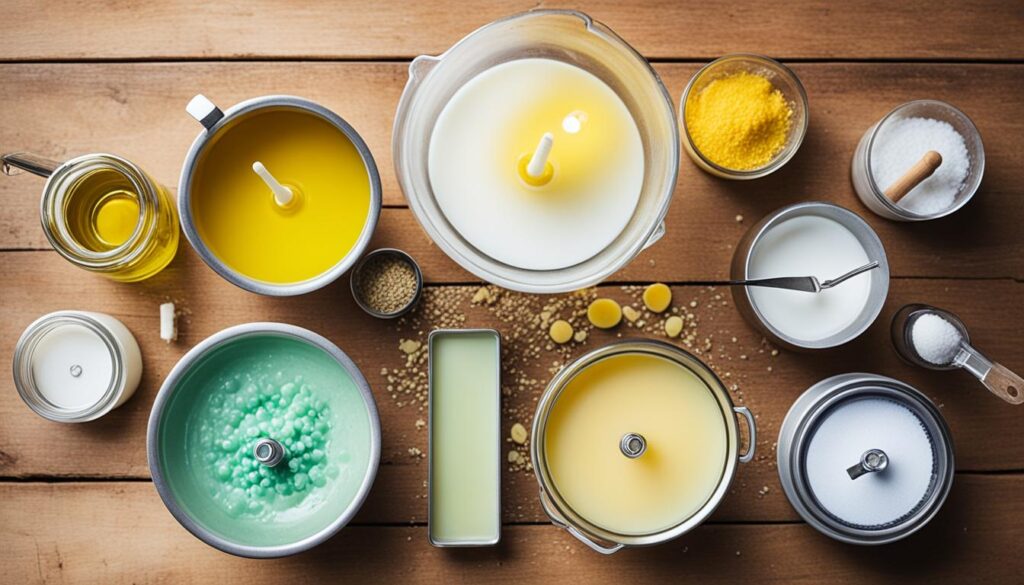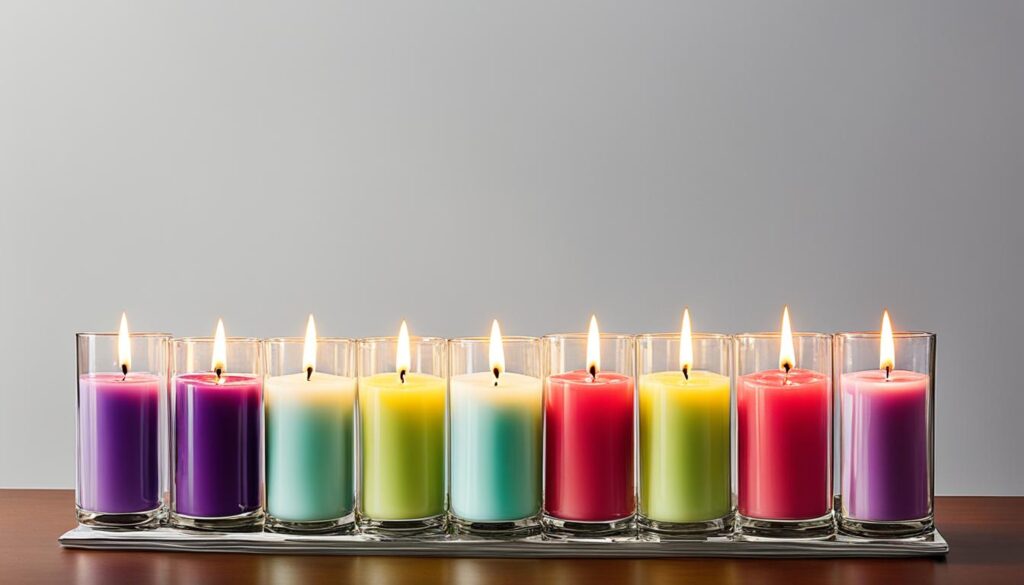How to Achieve a Strong Scent Throw in Your Candles
Making candles with a strong scent is key to grabbing your customers’ attention and giving them a memorable experience. Ever wondered what makes some candles stand out? This guide will show you how to make scented candles that leave a mark.
Key Takeaways
- Understand the importance of both hot and cold throw for customer attraction and retention.
- Ensure proper wax temperature and thorough fragrance oil mixing for optimal scent binding.
- Determine the ideal fragrance load to avoid wax overloading and oil pooling.
- Use precise measurements and conduct burn tests to achieve the perfect melt pool.
- Choose the right fragrance oils and allow for proper curing time to maximize scent throw.
Starting your candle-making journey, you might wonder what makes some candles have a strong scent. The secret is in balancing hot and cold throw, keeping wax at the right temperature, and finding the best fragrance load. We’ll guide you through these steps to make candles that will wow your customers.
Mastering Hot and Cold Throw
For candle lovers, knowing the difference between hot and cold throw is key. Hot throw is how strong the candle smells when it’s lit. Cold throw is how strong it smells before you light it. Both are important for a great scent experience.
Understanding Hot and Cold Throw
Hot throw is checked 2-4 hours after lighting. It shows how strong the candle’s scent throw is while it’s burning. A strong hot throw means your customers will love the candle fragrance they get.
Cold throw is the smell before the candle is lit. It’s important for drawing in customers and showing off your candle scent.
Importance of Cold Throw for Customer Attraction
A strong cold throw pulls customers in and makes them want to buy your candle performance. The inviting smell before it’s lit can make someone decide to buy it. Mastering cold throw makes your candles stand out.
Importance of Hot Throw for Customer Retention
A strong cold throw grabs attention, but a great hot throw keeps customers coming back. When customers smell the amazing scent throw of your candle, they’ll likely buy more and tell others. This keeps your candle fragrance business going strong.
Understanding hot and cold throw helps you make better candles. You can create a perfect mix of these elements for a scent experience your customers will love.
Ensuring Proper Wax Temperature
Creating candles with a strong scent throw requires the right wax temperature. The ideal temperature for adding fragrance oil is 185°F. At this temperature, the oil mixes well with the wax, making the scent last longer.
Adding Fragrance Oil at 185°F
It’s important to watch the wax temperature and add fragrance oil at 185°F. This temperature helps the fragrance molecules blend with the wax. This creates a scent that fills the room when the candle is lit.
Thorough Stirring for Fragrance Binding
After adding fragrance oil to the 185°F wax, stir it for at least 2 minutes. This ensures the fragrance and wax bond well. A strong bond means a better scent throw and a more enjoyable candle.
“Maintaining the correct wax temperature and stirring technique are crucial steps in the candle-making process.”
Follow these steps for wax temperature, adding fragrance oil, and stirring well. This will give your candles a strong, lasting scent. These skills will improve your candle-making and make your candles more enjoyable for everyone.
Determining Optimal Fragrance Load
Making candles with a strong scent is all about finding the right balance. The amount of fragrance oil you use is key to a lasting aroma. But, adding too much can cause problems that ruin the candle experience.
Starting Below Maximum Fragrance Load
It’s wise to start with a bit less fragrance oil than the wax can hold. For example, with 464 Soy Wax, 8% fragrance oil is a good starting point. This lets you adjust the scent without overloading the wax or causing oil to pool. These issues can hurt the candle’s performance and scent throw.
Avoiding Wax Overloading and Oil Pooling
- Using too much fragrance load can make the wax too full, causing wax overloading and oil pooling.
- These issues reduce the fragrance oil percentage and harm the candle’s performance. They affect burn quality and how long the candle lasts.
- Start with less fragrance load and slowly add more until you get the perfect scent. This way, you avoid problems and get a great scent throw.
| Wax Type | Recommended Fragrance Load Range |
|---|---|
| 464 Soy Wax | 6-8% fragrance oil |
| Paraffin Wax | 6-10% fragrance oil |
| Coconut Wax | 8-12% fragrance oil |
The best fragrance load depends on the wax type. So, it’s important to try different amounts to find what works best for your candles. Start with a little less fragrance oil and add more as needed. This way, you’ll get a wonderful scent throw without any issues with the candle’s performance.
Using Precise Measurements
Creating captivating candles requires precision. Candle making measurements are key for consistent results and a great experience for customers.
Weighing Supplies on a Scale
Getting a reliable scale changes the game for candle-making. By weighing supplies like wax and fragrance oils, you make sure your candles are always the same. This leads to predictable performance and a candle recipe consistency your customers will enjoy.
Avoiding Volume Measurements
It might seem easy to use cups and spoons, but don’t do it. Volume measurements can lead to mistakes, affecting your candles’ quality and performance. Always use precise weighing supplies for the best results.
“Accurate measurements are the foundation for creating candles with a strong, consistent scent throw.”
Using precise candle making measurements helps you make candles that will capture your customers’ hearts from start to finish.

Achieving the Perfect Melt Pool
Making candles with a strong scent throw is all about getting the melt pool right. This key part lets the fragrance spread well, giving your customers a great smell. It’s what makes your candles stand out.
Selecting the Right Wick Size
Picking the right wick size is key for your candle’s success. Make sure the wick fits your candle and the wax you use. A good wick size means the melt pool goes all the way to the edge. This lets the scent spread fully.
Conducting Burn Tests
Doing burn tests is a must to get your candle’s melt pool, flame size, and burn right. This helps you find the best wick for your candles. It makes sure they have a strong scent that your customers will remember.
- Watch how big the melt pool gets as it burns.
- Check the flame’s height and if it’s steady, not too big, or flickering a lot.
- See how long the candle burns and how much wax it uses to check its efficiency.
By testing and tweaking your candle’s wick and burn, you can make sure they always have a great melt pool and strong scent. This will impress your customers every time.
| Wick Size | Melt Pool Diameter | Flame Height | Burn Time |
|---|---|---|---|
| CD-10 | 3 inches | 1 inch | 8 hours |
| CD-12 | 4 inches | 1.5 inch | 10 hours |
| CD-14 | 5 inches | 2 inch | 12 hours |
Considering Candle Diameter
The diameter of a candle container is key to creating captivating candles with a strong scent. The size of the melt pool, or the liquefied wax around the wick, affects how much fragrance is released. Bigger containers mean a larger melt pool, which means a stronger scent that draws in customers.
To pick the best candle diameter, try different sizes. Test various containers and see how they change the melt pool size and scent throw. This way, you learn how the diameter, melt pool, and scent throw work together. This knowledge lets you make candles that offer a great smell experience.
“The size of the melt pool is the key to unlocking a captivating scent throw. Experiment with different candle diameters to find the sweet spot for your unique fragrance blends.”
But remember, the diameter isn’t the only thing that affects the scent. Other things like the wick, wax temperature, and how much fragrance you use are also important. By thinking about these factors together, you can make candles that really stand out and impress your customers.

Being good at candle making means balancing many design elements. Knowing how the diameter affects the melt pool and scent throw helps you make the most of your candles. This way, your customers will love the strong, inviting smell of your candles.
strong scent throw candles
For a strong scent in your candles, pick the right fragrance oils and cure them well. It’s key to use high-quality oils made for candles to get the best scent.
Choosing the Right Fragrance Oils
When picking fragrance oil selection, go for oils meant to give a strong, lasting smell. Choose oils with high fragrance oil strength for a room-filling aroma. Talk to candle suppliers or experts to find the best oils for your candles.
Ensuring Proper Curing Time
Also, let the candles cure for 1-2 weeks, especially for soy wax. This lets the fragrance mix well with the wax, making the scent stronger. After curing, the fragrance blends fully with the wax, giving a better scent when lit.
“Proper candle curing is key for a strong, lasting scent. Be patient and let your candles cure as directed to get the best smell.”
By picking the right oils and curing them right, you can make candles with a great scent. This will impress your customers.
Setting Realistic Expectations
Setting realistic expectations is key when it comes to candle scent throw. Environmental factors and individual differences in scent perception can affect how strong a candle smells. It’s important to keep this in mind.
Environmental Factors Affecting Scent Throw
The size of the room, humidity, and air circulation can change how a candle’s scent is felt. For instance, a candle might smell strong in a small, airy room but not as much in a big, closed one. Knowing this can help you make candles that meet your scent throw goals.
Individual Perception of Scent Varies
People can smell things differently because of their health, medicines, or personal taste. What smells strong to one person might be weak to another. This means you should set realistic scent throw expectations to please everyone.
Understanding how the environment and personal differences affect scent can help you make candles that everyone will enjoy. This way, you can make sure your customers love the scent of your candles.
Conclusion
Making candles with a strong, lasting scent throw takes careful attention. You need to consider wax temperature, fragrance amount, wick size, and curing time. By getting these right, you can make candles that fill spaces with lovely smells and bring customers back.
It’s important to try out different wax types, wick sizes, and fragrance amounts. This way, you can find the best mix for a strong, lasting scent. Keep an eye on your process and make changes as needed to make your candles stand out.
Keeping quality high and paying attention to details is key as you improve your candle-making. With the right approach, you can grow your candle business. You’ll make candles that truly delight your customers.
FAQ
What is the difference between hot throw and cold throw in candles?
Why is it important to add fragrance oil at the optimal temperature of 185°F?
What is the recommended fragrance load for 464 Soy Wax?
Why is it crucial to use precise measurements when making candles?
How does the size of the candle container affect the scent throw?
What factors should I consider when setting realistic expectations for my candles’ scent throw?
Source Links
- https://www.candlescience.com/learning/candle-making-101-hot-throw/ – Candle Making 101: Hot Throw
- https://nightskycandle.com/blogs/news/cold-throw-hot-throw-soy-candles – Get strong cold and hot throw from your Soy Candles
- https://www.reddit.com/r/candlemaking/comments/18lsuhh/how_do_i_increase_my_candles_scent_crafter/ – Reddit – Dive into anything
- Fragrance That Wows: A Beginner’s Guide to Adding Scents to Your Homemade Candles
- best essential oils for candles
- wood wick guide
- how to make candles smell stronger
- how to ship candles
- how to fix soy wax frosting
- wick Guide how to choose the right wick size with chart
- how to make candle molds
- how to clean candle wax
- how to reuse candle jars
- soy wax candle troubleshooting
- best wax melter for candle making
- how to conduct burn test
- why candle flickering crackling smoking
- how much wax per candle
- how to make candles smell stronger
- Easy Ways to Increase the Scent Throw of Your DIY Candles
- How to Make Candles for Meditation and Relaxation
- Using Upcycled Materials in Candle Making
- How to Make Hand-Poured Candles: Tips and Techniques

Leave a Reply